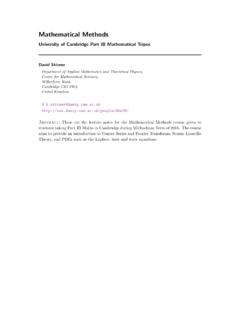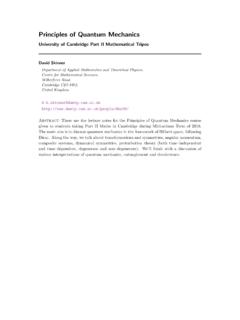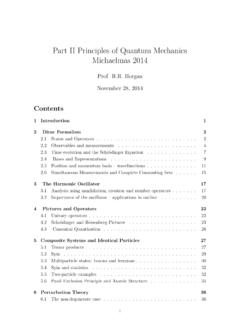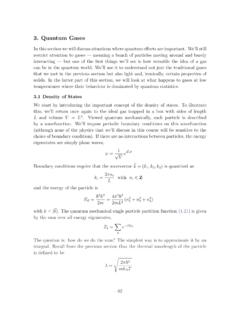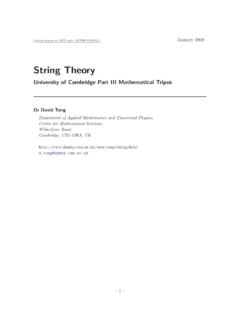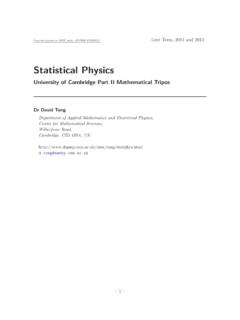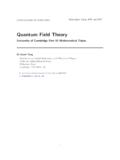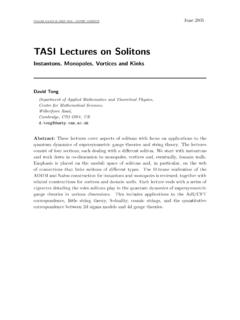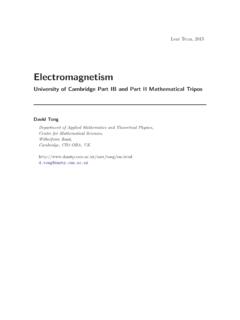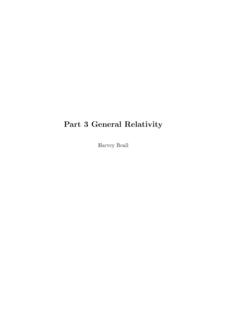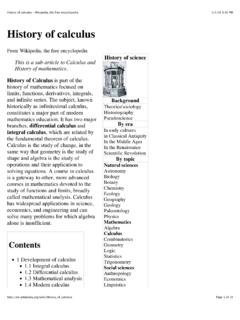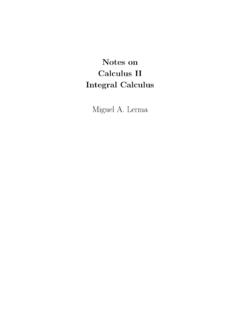Transcription of Electromagnetism - University of Cambridge
1 Lent Term, 2015 ElectromagnetismUniversity of Cambridge Part IB Mathematical TriposDavid TongDepartment of Applied Mathematics and Theoretical Physics,Centre for Mathematical Sciences,Wilberforce Road, Cambridge , CB3 OBA, Equations E= 0 B= 0 E= B t B= 0(J+ 0 E t) 1 Recommended Books and ResourcesThere is more or less a well established route to teaching Electromagnetism . A numberof good books follow this. David J. Griffiths, Introduction to Electrodynamics A superb book. The explanations are clear and simple. It doesn t go much beyondwhat we do in this course, but if you re looking for a book to cover the basics then thisis the first one to look at.
2 Edward M. Purcell and David J. Morin Electricity and Magnetism Another excellent book to start with. It has somewhat more detail in places thanGriffiths, but the beginning of the book explains both Electromagnetism and vectorcalculus in an intertwined fashion. If you need some help with vector calculus basics,this would be a good place to turn. If not, you ll need to spend some time disentanglingthe two topics. J. David Jackson, Classical Electrodynamics The most canonical of physics textbooks. This is probably the one book you can findon every professional physicist s shelf, whether string theorist or biophysicist.
3 It willsee you through this course and next year s course. The problems are famously it does have div, grad and curl in polar coordinates on the inside cover. A. Zangwill, Modern Electrodynamics A great book. It is essentially a more modern and more friendly version of , embarrassingly, Maxwell s equations on the inside cover have a typo. Feynman, Leighton and Sands, The Feynman Lectures on Physics, Volume II Feynman s famous lectures on physics are something of a mixed bag. Some explanationsare wonderfully original, but others can be a little too slick to be helpful. And much ofthe material comes across as old-fashioned.
4 Volume two covers Electromagnetism and,in my opinion, is the best of the number of excellent lecture notes , including the Feynman lectures, are availableon the web. Links can be found on the course webpage: 2 Contents1. and Conservation and Maxwell Equations62. Coulomb Uniform Charges and Electrostatic Point Charge Energy of a Point Force Between Electric Value of many more History of Electrostatics393. `ere s Long Straight Currents and Vector Monopoles47 3 Mathematical Diversion: The Linking Current Current Between and Energy for a What is a Magnet?
5 Of History of Magnetostatics654. s Law of s Law for Moving and Magnetostatic Faraday (1791-1867) Last Thing: The Displacement Amp`ere s Law is Not There Was the Wave Application: Reflection off a Clerk Maxwell (1831-1879) of Energy: The Poynting Continuity Equation Revisited945. Electromagnetism and Review of Special Up, Indices , Covectors and and Potentials and the Electromagnetic Tensor105 4 Invariance and Electromagnetic Example: A Boosted Line Example: A Boosted Point Lorentz Force in Constant 5 AcknowledgementsThese lecture notes provide an introduction to Electromagnetism .
6 They assume afamiliarity with Newtonian mechanics and special relativity, as covered in theDynamicsand Relativitynotes. They also assume a knowledge of vector calculus . 6 1. IntroductionThere are, to the best of our knowledge, four forces at play in the Universe. At the verylargest scales those of planets or stars or galaxies the force of gravity the very smallest distances, the two nuclear forces hold sway. For everything inbetween, it is force of Electromagnetism that the atomic scale, Electromagnetism (admittedly in conjunction with some basicquantum effects) governs the interactions between atoms and molecules.
7 It is the forcethat underlies the periodic table of elements, giving rise to all of chemistry and, throughthis, much of biology. It is the force which binds atoms together into solids and it is the force which is responsible for the incredible range of properties thatdifferent materials the macroscopic scale, Electromagnetism manifests itself in the familiar phenom-ena that give the force its name. In the case of electricity, this means everything fromrubbing a balloon on your head and sticking it on the wall, through to the fact that youcan plug any appliance into the wall and be pretty confident that it will work.
8 For mag-netism, this means everything from the shopping list stuck to your fridge door, throughto trains in Japan which levitate above the rail. Harnessing these powers through theinvention of the electric dynamo and motor has transformed the planet and our liveson if this wasn t enough, there is much more to the force of Electromagnetism for itis, quite literally, responsible for everything you ve ever seen. It is the force that givesrise to light remarkably, a full description of the force of Electromagnetism is contained infour simple and elegant equations. These are known as theMaxwell equations.
9 Thereare few places in physics, or indeed in any other subject, where such a richly diverseset of phenomena flows from so little. The purpose of this course is to introduce theMaxwell equations and to extract some of the many stories they , there is also a second theme that runs through this course. The force ofelectromagnetism turns out to be a blueprint for all the other forces. There are variousmathematical symmetries and structures lurking within the Maxwell equations, struc-tures which Nature then repeats in other contexts. Understanding the mathematicalbeauty of the equations will allow us to see some of the principles that underly the lawsof physics, laying the groundwork for future study of the other forces.
10 1 Charge and CurrentEach particle in the Universe carries with it a number of properties. These determinehow the particle interacts with each of the four forces. For the force of gravity, thisproperty is mass. For the force of Electromagnetism , the property is the purposes of this course, we can think of electric charge as a real number,q R. Importantly, charge can be positive or negative. It can also be zero, in whichcase the particle is unaffected by the force of SI unit of charge is theCoulomb, denoted byC. It is, like all SI units, a parochialmeasure, convenient for human activity rather than informed by the underlying lawsof the physics.
